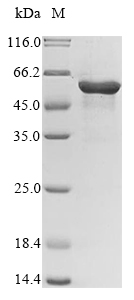Recombinant Human Paired box protein Pax-8 (PAX8) is produced in an E.coli expression system, which appears to ensure high-quality synthesis. This full-length protein spans amino acids 1-450. It comes with both an N-terminal 10xHis-tag and a C-terminal Myc-tag, making detection and purification more straightforward. The protein shows a purity level exceeding 90%, as verified by SDS-PAGE, and is intended for research use only.
PAX8 serves as a transcription factor that's crucial to developmental processes, particularly those involving the thyroid gland. The protein is actively involved in regulating gene expression necessary for organogenesis. Research on PAX8 may be vital for understanding its role in cellular differentiation and developmental pathways. This work likely contributes to broader insights in molecular biology and genetics.
Potential Applications
Note: The applications listed below are based on what we know about this protein's biological functions, published research, and experience from experts in the field. However, we haven't fully tested all of these applications ourselves yet. We'd recommend running some preliminary tests first to make sure they work for your specific research goals.
PAX8 is a transcription factor containing a DNA-binding paired domain and requires precise folding for its transcriptional activity. E. coli, as a prokaryotic system, lacks the eukaryotic chaperones and post-translational modification machinery necessary for proper folding of complex eukaryotic transcription factors. The dual tagging system, particularly the large tags, may sterically interfere with the DNA-binding domain and functional regions. Without experimental validation (e.g., electrophoretic mobility shift assays for DNA binding), the protein cannot be assumed to be correctly folded or bioactive. The high purity indicates low impurities, but does not guarantee functional conformation.
1. Antibody Development and Validation Studies
The recombinant PAX8 can serve as an immunogen for generating antibodies against linear epitopes, even if misfolded. The dual tags provide additional epitopes for antibody screening. However, antibodies generated may not recognize conformational epitopes of native, properly folded PAX8. Validate antibody specificity against endogenous PAX8 from human cell nuclei.
2. Protein-Protein Interaction Studies
The dual tags enable pull-down assays, but if PAX8 is misfolded, interactions may be non-physiological. The tags themselves may cause artifactual binding. Validate any identified interactions (especially with known partners like transcription cofactors) using full-length PAX8 from eukaryotic expression systems.
3. Biochemical Characterization and Stability Studies
The recombinant PAX8 is suitable for basic biophysical analysis (e.g., thermal stability, aggregation state). However, data may not reflect native PAX8 properties due to potential misfolding and the dual tags. Use techniques like circular dichroism to assess secondary structure, but interpret results cautiously without DNA-binding validation.
4. ELISA-Based Quantitative Assays
Feasible for developing ELISA assays, but if PAX8 is misfolded, the assay may not accurately quantify native PAX8. The tags may block epitopes or affect antibody binding. Validate the ELISA with native PAX8 standards from eukaryotic cells to ensure correlation with physiological levels.
Final Recommendation & Action Plan
Before using this recombinant PAX8 for functional studies, validate its folding and DNA-binding capability. Start with an electrophoretic mobility shift assay (EMSA) using a known PAX8-binding DNA sequence to confirm DNA-binding activity. If active, proceed with interaction or functional studies; if inactive, limit use to non-functional applications like antibody production (with validation against native PAX8). For reliable results, consider expressing PAX8 in a eukaryotic system (e.g., mammalian cells) that supports proper folding. Always include appropriate controls with native PAX8 when possible.






